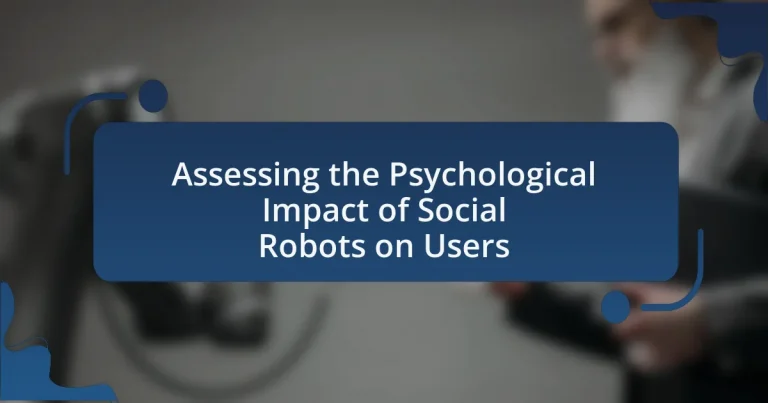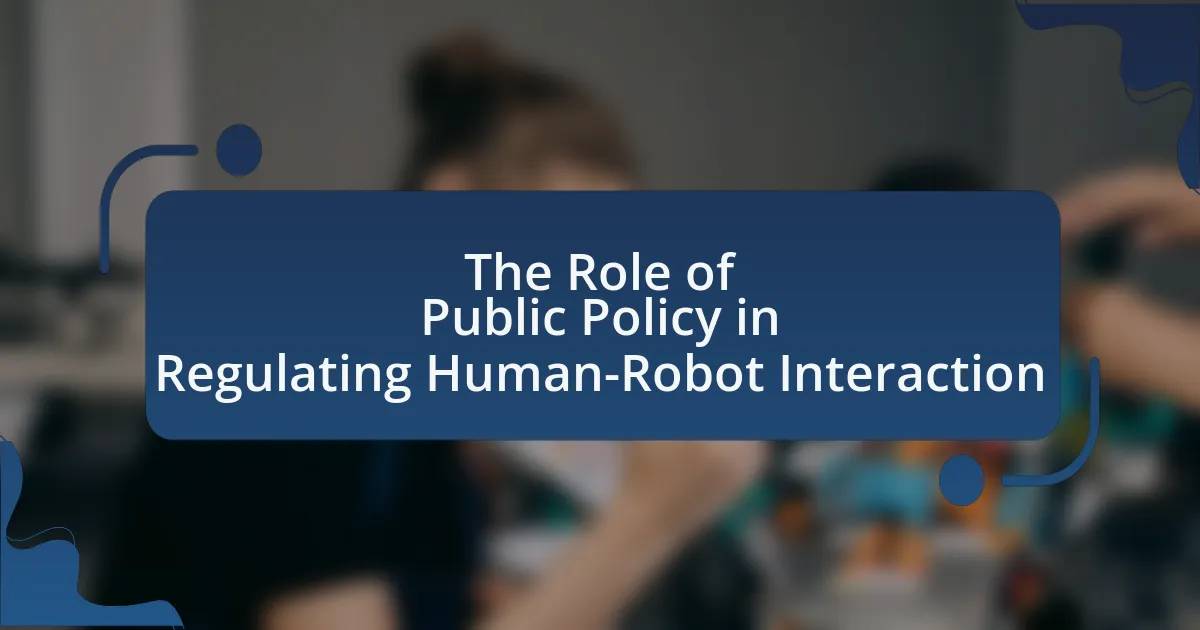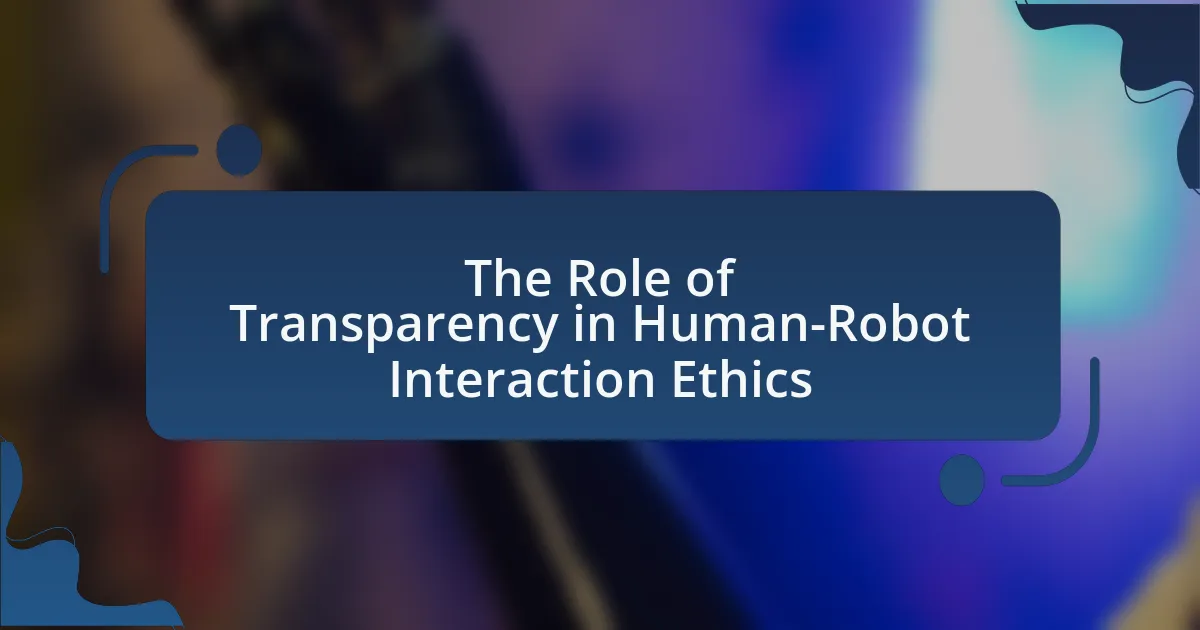The article examines the psychological impact of social robots on users, highlighting their effects on emotional well-being, social interaction, and potential dependency. It discusses how social robots utilize social cues to foster engagement and companionship, leading to increased feelings of happiness and reduced loneliness, particularly among elderly users. Key psychological theories, such as the Uncanny Valley and Attachment theory, are explored to understand user interactions and emotional responses. The article also addresses the benefits of social robots in therapeutic settings, the risks of dependency and privacy concerns, and the factors influencing user experiences across different demographics. Finally, it outlines best practices for designing socially impactful robots and anticipates future trends in human-robot interaction.

What is the Psychological Impact of Social Robots on Users?
The psychological impact of social robots on users includes enhanced emotional well-being, increased social interaction, and potential dependency. Research indicates that users often form emotional attachments to social robots, which can lead to improved mood and reduced feelings of loneliness. For instance, a study published in the journal “Social Robotics” by F. P. de Graaf and A. M. Allouch found that interactions with social robots can significantly increase users’ feelings of companionship and reduce anxiety levels. Additionally, while social robots can foster positive social behaviors, there is a risk of users developing an over-reliance on these robots for social interaction, potentially leading to decreased human-to-human interactions.
How do social robots interact with users psychologically?
Social robots interact with users psychologically by employing social cues and emotional responses that foster engagement and companionship. These robots utilize verbal and non-verbal communication, such as facial expressions, tone of voice, and body language, to create a sense of presence and emotional connection. Research indicates that users often anthropomorphize social robots, attributing human-like qualities to them, which enhances emotional bonding and trust. For instance, a study published in the journal “Robotics and Autonomous Systems” by Breazeal et al. (2016) found that users reported feelings of empathy and attachment towards robots that displayed social behaviors, demonstrating the psychological impact of these interactions.
What are the key psychological theories relevant to social robots?
Key psychological theories relevant to social robots include the Uncanny Valley theory, Social Presence theory, and Attachment theory. The Uncanny Valley theory posits that as robots become more human-like, they elicit a sense of unease when they are almost, but not quite, lifelike. This theory is supported by research indicating that humanoid robots can provoke discomfort in users when they appear too realistic without achieving full human likeness. Social Presence theory suggests that users perceive social robots as social actors, which can enhance user engagement and emotional responses. Studies have shown that higher levels of perceived social presence lead to increased user satisfaction and interaction with robots. Attachment theory explains how users can develop emotional bonds with social robots, similar to human relationships, which has been evidenced by research demonstrating that users often form attachments to robotic companions, impacting their emotional well-being.
How do social robots influence emotional responses in users?
Social robots influence emotional responses in users by providing social interaction that can evoke feelings of companionship, empathy, and comfort. Research indicates that users often form emotional attachments to social robots, which can lead to increased feelings of happiness and reduced feelings of loneliness. For instance, a study published in the journal “Science Robotics” by Breazeal et al. (2016) demonstrated that interactions with social robots can enhance users’ mood and emotional well-being, particularly in elderly populations. This emotional engagement occurs because social robots are designed to mimic human social behaviors, such as facial expressions and vocal tones, which can trigger empathetic responses in users.
What are the potential benefits of social robots on mental health?
Social robots can significantly enhance mental health by providing companionship, reducing feelings of loneliness, and offering emotional support. Research indicates that interactions with social robots can lead to improved mood and decreased anxiety levels among users. For instance, a study published in the journal “Frontiers in Psychology” by authors like K. Wada and T. Shibata found that elderly individuals who interacted with a robotic pet experienced lower levels of depression and increased social engagement. Additionally, social robots can facilitate therapeutic interventions, such as cognitive behavioral therapy, by providing a non-judgmental space for users to express their thoughts and feelings, further supporting mental well-being.
How can social robots reduce feelings of loneliness?
Social robots can reduce feelings of loneliness by providing companionship and social interaction. These robots are designed to engage users through conversation, emotional support, and interactive activities, which can mimic human-like interactions. Research has shown that individuals, particularly the elderly, experience decreased feelings of isolation when interacting with social robots, as evidenced by a study published in the journal “Gerontology” by Sherry Turkle, which found that elderly participants reported improved mood and reduced loneliness after regular interactions with social robots.
What role do social robots play in therapeutic settings?
Social robots play a significant role in therapeutic settings by providing companionship, emotional support, and facilitating communication for individuals, particularly in mental health and eldercare contexts. Research indicates that social robots can reduce feelings of loneliness and anxiety, enhance social interaction, and improve overall well-being. For instance, a study published in the journal “Healthcare” by K. K. K. Lee et al. (2020) found that interactions with social robots led to measurable improvements in mood and social engagement among elderly patients in care facilities. This evidence underscores the effectiveness of social robots as therapeutic tools in enhancing psychological health and fostering social connections.
What are the risks associated with social robots for users’ psychological well-being?
Social robots pose several risks to users’ psychological well-being, including dependency, social isolation, and emotional distress. Users may develop an unhealthy attachment to social robots, leading to dependency that can hinder real-life social interactions. Research indicates that reliance on robots for companionship can exacerbate feelings of loneliness and social isolation, as individuals may prioritize interactions with robots over human relationships. Additionally, the anthropomorphism of robots can lead to emotional distress when users perceive them as sentient beings, resulting in feelings of loss or grief when the robot malfunctions or is removed. These risks highlight the need for careful consideration of the psychological implications of integrating social robots into daily life.
How might social robots contribute to dependency issues?
Social robots can contribute to dependency issues by fostering emotional attachments that may lead users to rely on them for companionship and support. Research indicates that individuals, particularly the elderly or those with social anxiety, may develop strong bonds with social robots, perceiving them as substitutes for human interaction. This reliance can diminish social skills and reduce face-to-face interactions, as evidenced by studies showing that increased interaction with robots correlates with decreased social engagement in real-life settings. Consequently, the emotional reliance on social robots can create a cycle of dependency, where users increasingly turn to robots for emotional fulfillment rather than seeking human connections.
What are the concerns regarding privacy and data security with social robots?
Concerns regarding privacy and data security with social robots primarily involve the potential for unauthorized data collection and misuse of personal information. Social robots often gather sensitive data, such as user interactions, preferences, and biometric information, which can be vulnerable to hacking or exploitation. For instance, a study by the University of Cambridge highlighted that social robots could inadvertently expose users to privacy risks if their data is not adequately protected, leading to breaches that compromise user confidentiality. Additionally, the lack of clear regulations governing data usage in social robotics raises further concerns about accountability and transparency in how user data is handled.
How can we measure the psychological impact of social robots?
To measure the psychological impact of social robots, researchers can utilize a combination of quantitative and qualitative methods, including surveys, behavioral observations, and physiological measurements. Surveys can assess user attitudes, emotional responses, and perceived social presence, while behavioral observations can track interactions and engagement levels. Physiological measurements, such as heart rate variability and galvanic skin response, provide insights into emotional arousal during interactions with social robots. Studies, such as those conducted by Fong et al. (2003) in “The Role of Robots in Human Society,” demonstrate that these methods can effectively capture the nuanced psychological effects of social robots on users, validating their impact through empirical data.
What methodologies are used in assessing user experiences with social robots?
Qualitative and quantitative methodologies are used in assessing user experiences with social robots. Qualitative methods include interviews, focus groups, and observational studies, which provide in-depth insights into user perceptions and interactions. Quantitative methods involve surveys and experiments that measure user satisfaction, engagement, and emotional responses through statistical analysis. For instance, a study by Bartneck et al. (2009) utilized both qualitative and quantitative approaches to evaluate user experiences with social robots, demonstrating the effectiveness of combining these methodologies for comprehensive assessment.
How do we evaluate the long-term effects of social robots on users?
To evaluate the long-term effects of social robots on users, researchers employ longitudinal studies that track user interactions and psychological outcomes over extended periods. These studies often utilize standardized psychological assessments, such as the User Experience Questionnaire (UEQ) and the Positive and Negative Affect Schedule (PANAS), to measure changes in user attitudes, emotional responses, and social behaviors. For instance, a study by Kahn et al. (2012) demonstrated that consistent interaction with social robots can lead to increased feelings of companionship and reduced loneliness among elderly users, highlighting the potential positive psychological impacts. Additionally, qualitative methods, such as interviews and focus groups, provide deeper insights into user experiences and perceptions, further enriching the evaluation process.
What factors influence the psychological impact of social robots on different user demographics?
The psychological impact of social robots on different user demographics is influenced by factors such as age, cultural background, prior experiences with technology, and individual personality traits. For instance, older adults may experience increased comfort and companionship from social robots, while younger users might focus more on the novelty and entertainment aspects. Cultural background can shape perceptions and acceptance of robots, as seen in studies indicating that collectivist cultures may embrace social robots for community-oriented tasks more than individualistic cultures. Additionally, users with prior positive experiences with technology are likely to have a more favorable psychological response to social robots. Personality traits, such as openness to experience, can also affect how individuals interact with and perceive social robots, impacting their emotional responses and overall psychological well-being.
How does age affect user interaction with social robots?
Age significantly affects user interaction with social robots, as younger users tend to engage more positively and interactively compared to older users. Research indicates that children are generally more open to forming emotional connections with social robots, often viewing them as companions, while older adults may exhibit skepticism or discomfort due to unfamiliarity with technology. A study by Kahn et al. (2012) found that children showed higher levels of trust and willingness to interact with robots, whereas older adults expressed concerns about privacy and the reliability of robotic systems. This age-related difference in interaction styles highlights the importance of tailoring social robots to meet the varying needs and expectations of different age groups.
What cultural differences exist in the perception of social robots?
Cultural differences significantly influence the perception of social robots, with variations observed in attitudes, acceptance, and emotional responses across different societies. For instance, in Japan, social robots are often viewed positively and integrated into daily life, reflecting a cultural affinity for technology and anthropomorphism, as evidenced by the popularity of robots like ASIMO and Pepper. Conversely, in Western cultures, such as the United States, there is a more cautious approach, where concerns about privacy, job displacement, and ethical implications dominate discussions about social robots. Research by K. K. K. Lee and colleagues in “Cultural Differences in Attitudes Toward Robots” (2019) highlights that collectivist cultures tend to embrace robots for their potential to enhance social harmony, while individualistic cultures prioritize personal autonomy and express skepticism towards robotic integration. These cultural frameworks shape how individuals interact with and accept social robots, ultimately affecting their psychological impact on users.
What are the best practices for designing socially impactful robots?
The best practices for designing socially impactful robots include user-centered design, ethical considerations, and interdisciplinary collaboration. User-centered design ensures that robots meet the needs and preferences of the target population, which is crucial for fostering acceptance and positive interactions. Ethical considerations involve addressing privacy, consent, and the potential for bias in algorithms, as highlighted by the IEEE Global Initiative on Ethics of Autonomous and Intelligent Systems. Interdisciplinary collaboration brings together insights from psychology, sociology, and engineering, enhancing the robot’s ability to engage effectively with users. These practices are supported by research indicating that socially aware design leads to improved user satisfaction and trust in robotic systems.
How can developers ensure ethical considerations in social robot design?
Developers can ensure ethical considerations in social robot design by integrating user-centered design principles that prioritize user well-being and privacy. This approach involves conducting thorough user research to understand the psychological impacts of social robots, ensuring that the design process includes diverse user perspectives to mitigate biases. For instance, the IEEE Global Initiative on Ethics of Autonomous and Intelligent Systems provides guidelines that emphasize transparency, accountability, and the importance of user consent in data collection. By adhering to these ethical frameworks, developers can create social robots that respect user autonomy and promote positive interactions, ultimately enhancing user trust and satisfaction.
What features enhance the positive psychological impact of social robots?
Features that enhance the positive psychological impact of social robots include emotional expressiveness, social presence, and adaptability. Emotional expressiveness allows robots to convey feelings through facial expressions and vocal tones, which fosters emotional connections with users. Social presence, characterized by the robot’s ability to engage in natural conversations and respond to social cues, creates a sense of companionship. Adaptability enables robots to tailor interactions based on user preferences and emotional states, enhancing user satisfaction and comfort. Research indicates that these features contribute to improved mental well-being, as users report feeling less lonely and more supported when interacting with socially intelligent robots.
What future trends should we anticipate in the psychological impact of social robots?
Future trends in the psychological impact of social robots include increased emotional attachment and reliance on these robots for companionship and support. As social robots become more sophisticated in their interactions, users are likely to develop stronger emotional bonds, similar to those formed with pets or human companions. Research indicates that individuals, particularly the elderly and those with social anxiety, may experience reduced feelings of loneliness and improved mental well-being through interactions with social robots. For instance, a study published in the journal “Science Robotics” by F. D. M. de Graaf and A. A. M. Allouch in 2017 found that users reported positive emotional responses and increased social engagement when interacting with social robots. Additionally, ethical considerations regarding dependency and the potential for social robots to replace human interaction will become increasingly relevant as their presence in daily life grows.
How might advancements in AI change user interactions with social robots?
Advancements in AI will enhance user interactions with social robots by enabling more natural and intuitive communication. As AI algorithms improve, social robots will better understand and respond to human emotions, gestures, and speech patterns, leading to more personalized and engaging interactions. For instance, research indicates that robots equipped with advanced natural language processing can interpret user intent and emotional cues, significantly improving user satisfaction and emotional connection (Breazeal, C., 2016, “Social Robots: The New Frontier in Human-Robot Interaction,” MIT Press). This capability fosters trust and rapport, making users more likely to engage with social robots in various contexts, from companionship to assistance in daily tasks.
What implications do emerging technologies have for the psychological effects of social robots?
Emerging technologies significantly influence the psychological effects of social robots by enhancing user interaction and emotional engagement. For instance, advancements in artificial intelligence and machine learning enable social robots to better understand and respond to human emotions, fostering a sense of companionship and reducing feelings of loneliness. Research indicates that users often develop emotional attachments to social robots, which can lead to improved mental well-being, as seen in studies where elderly individuals reported increased happiness and reduced anxiety when interacting with robotic companions. Furthermore, the integration of natural language processing allows for more meaningful conversations, enhancing the perceived intelligence and relatability of social robots, which can positively impact users’ mental health by providing social support.
What practical tips can users follow to maximize the benefits of social robots?
To maximize the benefits of social robots, users should engage with them regularly and in varied contexts. Regular interaction enhances familiarity and comfort, which can lead to improved emotional responses and social bonding. Additionally, users should set clear expectations for the robot’s capabilities, as understanding its functions can prevent frustration and enhance satisfaction. Research indicates that consistent use of social robots can lead to increased feelings of companionship and reduced loneliness, particularly among older adults. Furthermore, users should provide feedback to improve the robot’s performance, as this can lead to better personalization and responsiveness, ultimately enhancing the user experience.





